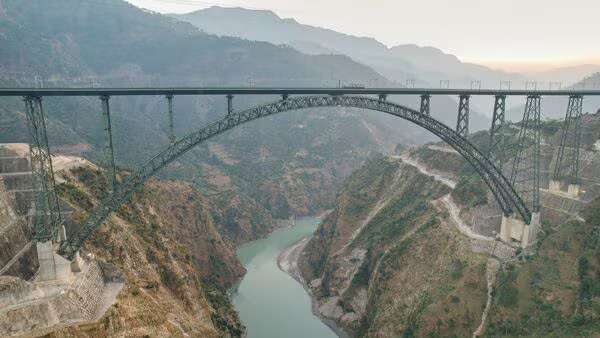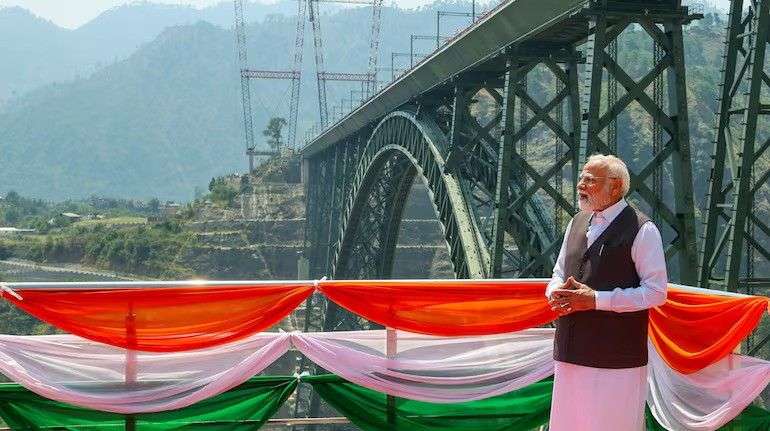In addition to being a milestone in engineering, the Chenab Rail Bridge represents a deeper geopolitical asset for India, especially in the context of Jammu and Kashmir and the geoeconomics of its neighboring countries. The implications of the bridge are deeply strategic and go far beyond simple connectivity and infrastructure. The bridge supports India’s national security, regional stability, and geopolitical posture.
Geopolitical Significance of the Chenab Rail Bridge
The Chenab Rail Bridge was opened on the 6th of June 2025 in Katra, Reasi District of Jammu and Kashmir, and is an iconic achievement that signifies India’s engineering ingenuity and strategic vision. The bridge is an extraordinary steel arch bridge located at an impressive 359 meters above the Chenab River, making it the highest railway bridge in the world. The Chenab Bridge is a concrete representation of India’s desire to transmigrate Jammu and Kashmir into the Union of India in a full and thorough manner. The rail link physically and symbolically connects the Kashmir Valley directly into the Indian railway network, allowing India to truly create a physical and symbolic bridge linking a region of geographic isolation and political turmoil to the rest of India.
This new form of integration supports the government’s vision to create social integration and economic opportunity in an area that struggles with borderline separatist identities and cross-border threats. With the inauguration of the bridge, it comes after the amendment of Article 370 in 2019 that ended Jammu and Kashmir’s special autonomous status, as well as a prospect of strategizing a bid to normalize and stabilize Jammu and Kashmir through infrastructure and governance changes. The rail link is expected to ease the movement of people and goods, bolster tourism, and create jobs that address some of the causes of unrest.

Chenab Bridge’s Military and Strategic Mobility
From a defense perspective, the Chenab Bridge is a blessing. Jammu and Kashmir is perhaps the most militarized territory in the world next to Afghanistan and borders Pakistan and China, both of which have territorial claims and disputes with India. The ability to mobilize troops, military equipment, and supplies via rail with speed and reliability across the difficult Himalayan terrain is imperative for India’s operational readiness.
The bridge has been purposefully designed to withstand earthquakes up to magnitude 8, winds of 260 km/h, and even blasts. The bridge is an important link in military logistics that will remain standing during extreme weather and utility disruptions due to war or natural disasters. The bridge not only provides critical support for military logistics and strategic resilience, it also reduces reliance on vulnerable and contested roads that are subject to weather disruptions or sabotage. The bridge adds value on a socio-economic level because it reduces travel time to less than 3 hours by rail between Katra (Jammu) and Srinagar, compared to 5–8 hours by road. Building an important, reliable, all-weather connection is critical for providing socio-economic development in the region.
The location’s proximity to international borders and its past experiences with security issues bring timely military logistics into play. The Chenab Bridge’s solid, seismic-resistant and advanced blast-proof steel, rated to withstand severe wind speeds, ensures that the bridge remains viable, and India’s defence capacity stays intact during adverse developments.
Engineering Feats and Technological Advances of Chenab Bridge
Building the Chenab Bridge was a titanic feat, as engineers faced the difficult Himalayan environment, intense climatic conditions, and geological instability. It was a decade-long task that involved groundbreaking engineering practices and international collaborations with institutions such as the IITs and DRDO. The bridge’s main steel arch spans 467 meters, making it the longest of its kind in the world, with composite pylons rising 130 meters above ground.
Some of the unique construction practices employed on the project include incrementally erecting the bridge on a transition curve, a first in Indian Railways’ history and the use of the world’s tallest crossbar cable cranes. The bridge used the most hi-tech steel that can function at temperatures from -20°C to 40°C, and is capable of surviving in a high seismic zone (Zone V) and even explosions meaning it can last about 120 years.
The project also established new norms for quality control, including a dedicated on-site laboratory accredited by the National Accreditation Board for Testing and Calibration (NABL) to test every construction element at each stage. The bridge also includes an online monitoring and warning system for passengers’ safety and was designed to withstand blasts, recognizing the security sensitivity of the area.
Addressing Pakistan’s Influence and Economic Issues through Chenab Bridge
In both timing and scale, there is an enormous contrast between the Chenab Bridge project and Pakistan’s current economic and strategic challenges. India asserts its commitment by investing significantly in infrastructure to integrate and develop Jammu and Kashmir, whereas Pakistan is currently faced with economic instability and loan dependence. Recent events in Pakistan include budget cuts that led to the abandonment of many development projects.
Pakistan’s push to exert influence in the region is evident, and India has taken a public position against international aid for Pakistan, citing concerns that such funds could be diverted to support terrorism. As this dynamic evolves, and Pakistan attempts to counter India’s efforts which could prove costly it has increased its defense budgets, driven by the ongoing “security” rivalry with India. The Chenab Bridge represents India’s commitment to asserting control and development in Kashmir while simultaneously undermining Pakistan’s narrative.
In addition to its engineering achievement, the Chenab Bridge represents hope and progress for Jammu and Kashmir. It aims to revive tourism, stimulate the local economy, eliminate the region’s isolation, and improve connectivity. The increased access is expected to promote trade, enhance education and healthcare, and support social development and stabilization operations in Jammu and Kashmir.
Geopolitically, it establishes India’s credibility and commitment to sovereign nation-building and development. The inauguration, coming shortly after security operations like Operation Sindoor, confirms the government’s commitment to integrating Jammu and Kashmir through infrastructure more than through military solutions. It is a clear demonstration that India’s approach to solving complex issues of geography and security can succeed through innovation and sustained nation-building.

